Got 30 minutes? Then why not whip up this gorgeous Scottish salmon risotto with fresh peas and Tenderstem broccoli. It's simple to make and absolutely delicious!

If you've never made risotto, fear not. It couldn't be simpler.
You'll soften onion and garlic in butter, stir in rice and then add stock, ladleful by ladleful, stirring as it absorbs until you have a thick, creamy, irresistible risotto base.
You'll then add steamed peas, broccoli and salmon with a scattering of parmesan to complete the dish.

For this recipe, I'm using fresh Scottish salmon, which is a fantastically easy and versatile fish to cook with, making it perfect for families.

It's also a healthy choice! NHS guidance as of June 2020 suggests a healthy, well-balanced diet should consist of at least two 140g portions of fish per week, one of which should be an oily fish, rich in long-chain Omega-3 fatty acids, such as salmon.
This is because, according to the British Dietetics Association, oily fish:
- May protect the heart and blood vessels from disease.
- Supports healthy development of baby during pregnancy and breastfeeding.
- May help maintain good memory.
- May aid in prevention and treatment of depression.
- Provides nutrients such as vitamin A, vitamin D and protein.

Now, let's make this gorgeous salmon risotto, packed with flavour and ready in about half an hour!

Click to jump to a section!
- Is salmon risotto easy to make?
- What is the origin of risotto?
- What goes well with salmon risotto?
- Ingredients and variations
- Equipment
- Instructions with step-by-step photographs
- Allergen & dietary information
- How to store, keep, freeze and reheat risotto
- Troubleshooting this salmon risotto recipe
- Full printable recipe
- More fish recipe inspiration for your next family meal
Is salmon risotto easy to make?
Risotto is one of those things that seems like it might be complicated but it's actually really, really easy.
You simply soften onion and garlic in butter, then add the rice before incorporating the stock a little at a time. You'll lightly steam your salmon (no special kit required) and add that to the pan along with the green veg and parmesan and you're done.
So simple and so tasty.
What is the origin of risotto?
Risotto originated in northern Italy, where a version of the recipe dates back to 1809.
Today in Italy, it's typically served as a starter, while in the UK it's more commonly enjoyed as a main.
What goes well with salmon risotto?
This salmon risotto goes beautifully with crisp green salad, crusty bread and a crisp white wine for the grown ups, such as a Pinot Grigio.

Ingredients and variations
- 440 g (1 lb) salmon fillets skin and bones removed
- 1 lemon sliced
- 90 g (6 tbsp) salted butter
- 1 medium onion peeled and finely chopped
- 2 cloves (2) garlic peeled and chopped
- 200 g (1 cup) arborio rice
- 1 litre (4 cups) hot chicken stock gluten free if required
- 100 g (⅔ cup) fresh peas
- 100 g (3½ oz) tenderstem broccoli (broccolini)
- 30 g (⅓ cup) Parmesan finely grated
- pinch salt and black pepper
Click to jump to more information about:
Risotto Rice
Where can I buy arborio rice?
Arborio rice is stocked by pretty much all supermarkets and you should find it in the rice aisle. You might also find it labelled “risotto rice”. If so, just check the ingredients label on the back to make sure it is indeed arborio rice.
Do I have to use arborio rice?
Arborio rice grains have quite a rounded shape, which holds together well during cooking. It gives the perfect results for this dish so it’s well worth picking up arborio rice at the supermarket if you plan to make this recipe
Although I haven't tried it, you could use long grain rice in this recipe, but it will be higher in starch and will probably result in a sticky, dense risotto.
Salmon
Where can I buy Scottish salmon?
Scottish salmon is available from supermarkets and fishmongers throughout the UK. Check the labelling or ask your fishmonger if you're unsure.
Is Scottish salmon popular?
We might think of fish fingers as the most common way for UK families to enjoy fish, but in fact, salmon tops the list as the popular fish dish among UK shoppers (followed by cod and tuna) with £1.1 billion of sales in 2018.
According to the Scottish Salmon Producers Organisation (the body which represents Scotland’s salmon farm operators and champions the industry), Scottish salmon is the world’s favourite UK-produced food, with 75,000 tonnes sent abroad in 2018!
What are the health benefits of eating Scottish salmon?
Scottish salmon contains long-chain Omega-3 fatty acids, which may help prevent heart disease and, if consumed during pregnancy and breastfeeding, benefit baby’s development.
Salmon is also an excellent source of high-quality protein (around 35g per 140g serving), vitamins and minerals (including potassium, selenium and vitamin B12).
Scientists are investigating the role fish consumption may have in protecting people from some cancers, Alzheimer’s disease, depression, asthma, diabetes, macular degeneration, high blood pressure and multiple sclerosis.
Note: A Mummy Too is not a medical advice website. Please consult your health professional for advice.
Is Scottish salmon sustainable?
Farmed Scottish salmon are extremely efficient in converting feed into edible protein, with just 1.2 tonnes of responsibly sourced feed required to grow 1 tonne of fish.
Farmed salmon, when compared to other types of livestock such as chicken, pork and beef, has an extremely low carbon footprint and uses very little fresh water to grow.
All Scottish salmon is farmed in adherence to the Code of Good Practice – which sets out 500 points of compliance for seawater fish farming, focussing on the health and welfare of the livestock.
How can I tell if my salmon is fresh or has gone off?
Ideally, you should purchase your Scottish salmon on the same day you intend to cook it.
If that's not possible, your fish should be placed in the refrigerator as soon as you get home. Keep your fish wrapped up and place on ice to keep it well chilled.
A whole salmon should keep for an absolute maximum of three days when properly stored. Fresh Scottish salmon fillets are more exposed to air and so will generally keep for a maximum of two days.
Always check with your fishmonger as the timings and storage advice can vary slightly for different fish and different cuts. (For example, shellfish require a different approach to storage).
If your fish has a Use By date, always heed this.
If you've stored your fish correctly and within the advised time limits, you can use your senses to judge if it's safe.
Sight
Your fish should look fresh and bright? The eyes should be bright, bulging and clear. The flesh inside the gills should be red.
Has your fish changed colour or shape? Have the eyes turned cloudy or sunken? Are the gills dull, purple or brown? Do the scales or flesh look dull, faded or slimy?
If your fish is showing these or any other signs of degradation or contamination, it's time to throw it away.
Remember, you can't see bacteria on food, so if your fish has been handled unhygienically (e.g. by someone with unwashed hands) this will not show up. This is why it's important to buy good quality fish from a reputable fishmonger and to practice good hygiene practices yourself when handling the fish.
Smell
Fresh fish only smells mildly. If it smells more strongly, it probably isn't fresh and if it smells very strong, it's best not to eat it.
Touch
Fresh fish should feel firm and wet, older fish can develop a film or become slimy, it may also become softer.
If it doesn't feel absolutely fresh, it's not worth risking.
Vegetables
I haven’t got peas or broccoli can I use different vegetables?
Most green vegetables work well in the recipe. How about lightly fried courgettes, wilted spinach or blanched sugar snap peas and asparagus. All would be delicious!
Can I add extra vegetables to salmon risotto?
Yes, you can absolutely add extra veg to this recipe, just bear in mind that the veg heats up using the residual warmth from the rice.
So, if you are adding more, you'll probably want to steam it right before stirring through to ensure you have a piping hot dish without overcooking the rice.
Stock and seasonings
How to reduce the salt content?
If you want to reduce the salt in this recipe, I would recommend using unsalted butter and a reduced-salt stock.
Can I make this recipe without stock?
If you want to avoid added salt entirely, you could use boiling water instead of stock, or a homemade, unsalted chicken stock.
Variations
How can I add/change the flavours in this salmon risotto?
Salmon lends so well to so many great flavours. You could opt to use a half-strength stock in your risotto and then fold some green pesto through your dish in place of the parmesan.
Green beans, spinach and white beans, too are all great accompaniments to salmon.
Flavour-wise, you could try adding an extra dimension to this recipe with a squeeze of lemon juice, a pinch of chilli flakes or a handful of peppery rocket.
Can I make salmon risotto in a different quantity?
It’s very easy to adjust this recipe to make more or less.
Simply scroll down to the recipe card towards the bottom of this post and hover your mouse (or tap your finger) over the portion number.
You will then be shown a slider, which you can move up and down to change the number of portions the recipe will make. As you do so, all of the ingredient quantities will automatically change accordingly.
If you have any questions about changing the quantities, just ask!

Equipment
- Large deep frying pan with lid
- Medium saucepan with lid
Will I need any special equipment to make salmon risotto?
Not at all! You will probably have everything you need to make salmon risotto in your kitchen right now - just a couple of lidded pans, a wooden spoon, a chopping board and knife, a measuring jug and a grater.
Instructions with step-by-step photographs
Before you begin, lightly blanch your broccoli and peas by placing them in boiling water for 2 minutes, then plunging into cold water. Set aside.
Put the butter in a large pan.

Warm over a medium heat until just melted.

Add the onion and garlic.

Fry for about 3 minutes, until the onions start to turn translucent.

Add the arborio rice.

Stir well until the rice looks glossy, which should take a couple of minutes.

Now it’s time to start adding the stock. Add 250ml of stock and bring to the boil. Turn the heat down to low.
You don’t need to stir continuously but risotto isn't a dish to be left unattended. Make sure you stir regularly to avoid sticking or burning and so that you know when more liquid is needed.

In a few minutes, the liquid should be absorbed.

Continue adding stock, a ladleful at a time, stirring until the liquid has been absorbed.

The whole process will take about 20-25 minutes in total, at which point the rice should be al-dente (firm, but without chalkiness when chewed).

Add your blanched peas and broccoli.

Turn off the heat, pop the lid on your pan and leave for 5 minutes to allow the greens to heat through.

Meanwhile, line the bottom of a saucepan with lemon slices.

Sit the salmon on top.

Season the salmon and pour in enough boiling water to just reach the bottom of the salmon.

Put the lid on the pan.

Simmer for 5 minutes or until the salmon is cooked through.

Carefully transfer to a plate - it will be hot - and gently flake into pieces. Cooked salmon should flake easily.

Add the flaked salmon to the risotto.

Add the grated parmesan.

Stir and ensure everything is heated through. Turn the heat back on for a moment if needed.

Risotto should be rich and creamy, but still hold its shape a little - if you feel your risotto is too thick, you can add a splash more stock or boiling water and stir through gently.
Serve to bowls and enjoy!

Is salmon risotto recipe suitable for pescatarians, vegetarians or vegans?
This recipe contains chicken stock and Scottish salmon, so is not suitable for vegetarians and vegans.
If you use vegetable or fish stock instead of chicken stock, the recipe can be made suitable for pescatarians.
Is salmon risotto gluten-free?
None of the ingredients in this recipe naturally contain gluten.
Therefore, as long as you use gluten-free stock and check the labels on all other packaging to ensure they're free from gluten (this is because some products may pick up traces of gluten by way of factory cross-contamination).
Is salmon risotto keto-friendly?
Salmon, broccoli, butter and garlic are considered very suitable for a keto diet. Peas and onion are considered fine in small portions.
However, rice is a starchy grain, high in carbohydrate and so is not keto-friendly.
There isn't a keto alternative that will behave exactly like arborio rice. However, you lightly could cook cauliflower rice in chicken stock and serve with the salmon and veg to achieve a similar meal.
Is this salmon risotto healthy?
This risotto is packed with vitamins and minerals from the green veg, as well as protein and long chain Omega-3 fatty acids from the salmon, so it's a nutritious option.
If you'd like to reduce the saturated fat, you could swap the butter for a small amount of rapeseed oil (often just labelled as vegetable oil in the UK, or canola oil in the US), which is naturally low in saturated fat.
Is salmon risotto safe to eat while pregnant?
At the time of writing (June 2020), the UK National Health service recommends that it is safe for pregnant people to eat cooked fish and seafood, but states that “you should eat no more than 2 portions of oily fish a week, such as salmon, trout, mackerel or herring”.
There is nothing else in this recipe that should present a risk to pregnant people if the ingredients are in good condition and have been stored correctly, and the recipe is cooked hygienically and safely.
A Mummy Too does not offer medical advice. You can review the NHS advice here and you should consult with your medical professional regarding any concerns.

How should I store salmon risotto?
Risotto is at its best fresh from the pan. After cooking, the rice will continue to slowly absorb the remaining moisture, so the dish becomes softer and thicker.
That said, you can refrigerate leftover salmon risotto to eat later as long as you do so safely and accept that the quality won't be the same as when freshly cooked.
Cool your risotto, transfer to a sealed container and place in the fridge no more than an hour after making.
How long does salmon risotto keep?
If stored correctly in the refrigerator, your risotto should keep for 2-3 days. If it smells in any way unusual or off, discard it.
Can I leave salmon risotto out on the counter?
You must not leave this dish out on the counter at room temp as not only will this compromise taste and flavour, it could also allow bacteria to grow to unsafe levels, making the risotto unsafe to eat.
Can I make salmon risotto ahead?
I wouldn't recommend making this risotto ahead. After cooking, the rice will continue to slowly absorb the remaining moisture, so the dish becomes softer and thicker.
However, if you really need to, you can make it, cool it and transfer it to a sealed container in the fridge within an hour of making, where it should keep for 2-3 days.
Can I freeze salmon risotto?
Yes, you can freeze your Salmon risotto. However, bear in mind that it's likely to break down upon thawing, leaving soft bits and grainy bits, so it won't have the same lovely texture that it has fresh.
If you want to freeze it, transfer it to a sealed container and place in the freezer within an hour of making. Make sure it's completely cold as you don't want steam in the container creating additional frost.
Stored correctly, your risotto should keep for 2-3 months.
What is the best way to reheat salmon risotto?
If your risotto is frozen, place in the refrigerator overnight to thaw.
To cook your chilled risotto, you'll need to introduce some more liquid. Place your risotto in a pan and add a couple of tablespoons of stock for every ladleful of risotto.
Heat gently, stirring only occasionally until it is safely heated all the way through. You might find that your vegetables have gone a bit soft, so I'd suggest throwing in a handful of fresh spinach to brighten the dish back up.

Troubleshooting this salmon risotto recipe
How can I make sure my risotto is perfectly cooked?
I generally go by three indicators when making risotto: time, texture and taste.
Time: Risotto on a low simmer will take about 20-25 minute to cook. If it seems cooked after 5 minutes, it probably isn't!
Texture: A finished risotto looks almost like thick porridge. If your risotto is looking very liquid and you still have 1/4 of your stock left, chances are it is not ready. If it's been 20 minutes and your rice just isn't cooking, you probably have the heat too low. Turn it up a touch so that your liquid is simmering and keep going.
Likewise, if it seems super thick but you still have loads of stock left, that means it's ready for the next ladleful.
Taste: When you get to the last 1/4 of your stock, if your risotto is starting to look good, you can give it a little taste. Your rice should have a little bit of firm resistance to it, but it shouldn't feel hard, chalky, bitty or grainy.
How can I make sure my salmon is perfectly cooked?
Uncooked salmon is a glossy, dark reddish-pink with a slightly translucent quality. It should feel firm to the touch.
Cooked salmon is opaque, pale-pink and easily fakes along the white fat lines that run across the fillet.
If you've steamed your tuna for 5 minutes and you're not sure if it's read, press down on the top of fillet with a spoon. It should flake easily. If it doesn't, pop the lid back on and give it another minute or two.
Exact timings will depend on how cold the fish is going in and how thick the fillet is at its thickest part.
Why did my risotto turn out stodgy or thick?
If your risotto is too thick, it could either mean you didn't add enough stock or you cooked your risotto for a bit too long.
Taste your risotto, if the rice is grainy or chalky, add a ladleful of stock or hot water and gently stir over the heat to finish cooking your rice.
If your rice texture is good but you're prefer a looser risotto, simple stir in a splash of stock and then serve.
Why did my risotto turn out watery or thin?
If your risotto is thin, you either added too much stock or your risotto simply isn't finished cooking.
Taste your rice, it should be very slightly firm but not crunchy or grainy. If you think your rice needs more time to cook, simply keep simmering and stirring until the liquid has absorbed, your risotto has thickened up and your rice is cooked.
If your rice tastes cooked but you have too much liquid, you have added too much stock. Gently push your risotto to the edges of the pan. The liquid should pool in the centre where you can spoon or ladle it away.
You can then continue to briefly simmer and stir your risotto until you reach the desired thickness.
Why did my risotto turn out crunchy?
Your rice be very slightly firm but not crunchy or grainy.
If it's crunchy, simply add more stock and keep simmering and stirring until the liquid has absorbed, your risotto has thickened up and your rice is cooked.
If your risotto has crunch dark bits in it, it could be that it has caught and burned on the bottom of the pan. This is only likely if you have the heat much too high or leave the risotto unattended.
Why did my risotto taste bland?
Chicken stock is full of flavour, so should add a lovely dimension to the rice, while the salmon and veg add yet more incredible texture and flavour.
If your stock cube didn't add much flavour, it could be that it can gone paste its best. You can taste the stock before you use it to make sure your stock is still good.

Print this risotto recipe
Fresh Salmon Risotto Recipe
Ingredients
- 440 g (1 lb) salmon fillets skin and bones removed
- 1 lemon sliced
- 90 g (6 tbsp) salted butter
- 1 medium onion peeled and finely chopped
- 2 cloves (2) garlic peeled and chopped
- 200 g (1 cup) arborio rice
- 1 litre (4 cups) hot chicken stock gluten free if required
- 100 g (⅔ cup) fresh peas
- 100 g (3½ oz) tenderstem broccoli (broccolini)
- 30 g (⅓ cup) Parmesan finely grated
- pinch salt and black pepper
Equipment
- Large deep frying pan with lid
- Medium saucepan with lid
Instructions
- Before you begin, lightly blanch your broccoli and peas by placing them in boiling water for 2 minutes, then plunging into cold water. Set aside.
- Put the butter in a large pan. Warm over a medium heat until just melted.
- Add the onion and garlic. Fry for about 3 minutes, until the onions start to turn translucent.
- Add the arborio rice. Stir well until the rice looks glossy, which should take a couple of minutes.
- Now it’s time to start adding the stock. Add 250ml of stock and bring to the boil. Turn the heat down to low.
- You don’t need to stir continuously but risotto isn’t a dish to be left unattended. Make sure you stir regularly to avoid sticking or burning and so that you know when more liquid is needed. In a few minutes, the liquid should be absorbed.
- Continue adding stock, a ladleful at a time, stirring until the liquid has been absorbed.
- The whole process will take about 20-25 minutes in total, at which point the rice should be al-dente (firm, but without chalkiness when chewed).
- Add your blanched peas and broccoli. Turn off the heat, pop the lid on your pan and leave for 5 minutes to allow the greens to heat through.
- Meanwhile, line the bottom of a saucepan with lemon slices.
- Sit the salmon on top.
- Season the salmon and pour in enough boiling water to just reach the bottom of the salmon.
- Put the lid on the pan and simmer for 5 minutes or until the salmon is cooked through.
- Carefully transfer to a plate – it will be hot – and gently flake into pieces. Cooked salmon should flake easily.
- Add the flaked salmon and the grated parmesan to the risotto.
- Stir and ensure everything is heated through. Turn the heat back on for a moment if needed.
- Risotto should be rich and creamy, but still hold its shape a little – if you feel your risotto is too thick, you can add a splash more stock or boiling water and stir through gently.
- Serve to bowls and enjoy!
Video
Notes
Nutrition
This is a commissioned post for the Scottish Salmon Producers Organisation
Pin this salmon risotto

More fish recipes to try
Have you got my book?

'This is a great kids cookery book. Emily is a star' - Simon Rimmer
'The book I'd like to force into any mother's kitchen' - Prue Leith
"A fab book with a plan." - Jane Devonshire, 2016 Masterchef UK winner
'Emily has managed to combine her mummy knowledge and passion for food to make a truly helpful and brilliant cookbook' - Priya Tew, RD, BSc (Hons), Msc
Get Your Kids to Eat Anything is an achievable 'how to' for parents in the battle to overcome picky eating and 'make new the norm'. Emily Leary's unique 5-phase programme looks at the issue of 'fussy eating' in a holistic way that links imagination with food, and which situates parents alongside - not in opposition to - their children.








Sabra says
I didn't have arborio rice at home I made it with basmati but it turned out delicious! Adding lemon on the bottom of the saucepan gives a very fresh flavour to the salmon! I don't usually write a review but this recipe, made me write! I just loved it!!!
Jane says
I love this recipe I make it all the time for my daughter. Today I tried to double the recipe so I could freeze some for future. I had about 600ml of stock left though so I’m not sure if you double to do use less stock? Google said 2 cups to 1 cup rice - anyway it still tastes perfect and will continue to make again and again!
Emily Leary says
Hmm that's strange. It should be the case that you do indeed double the liquid if you double all of the other ingredients.
Miriam van Emst says
Delicious. Super easy, nutritious. I added in fresh parsley, Thai red chili and lemon rinds for a bit of extra kick.
Emily Leary says
That sounds incredible!
Mo says
Amazing recipe... my partner and my kids
Loved it. Easy, healthy and delicious...
Emily Leary says
I'm so pleased!